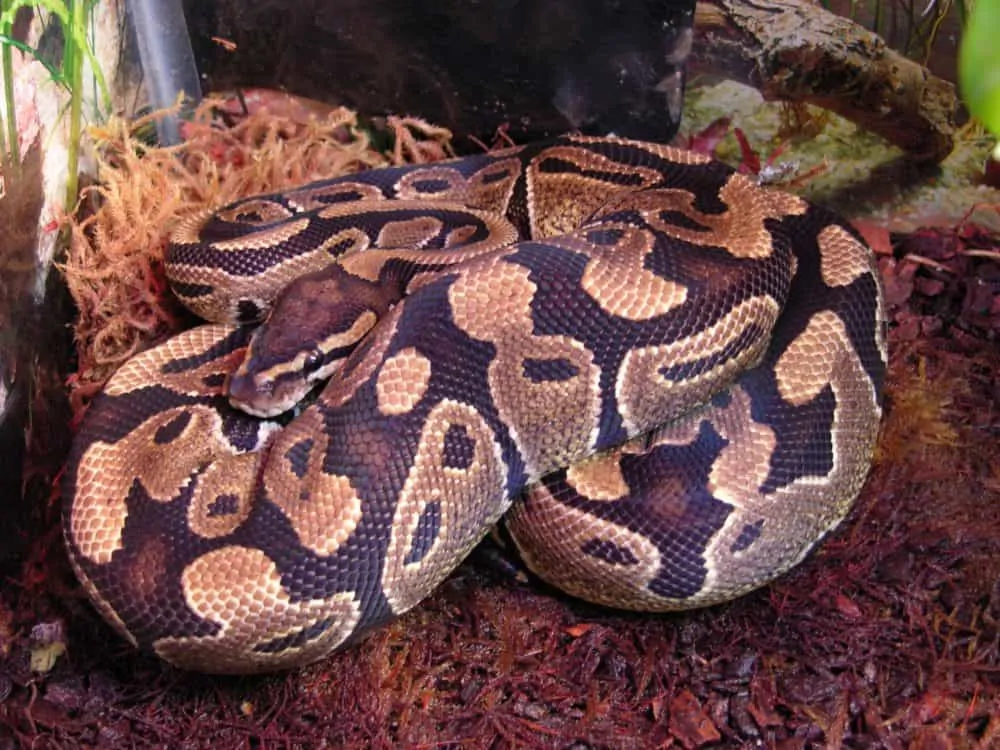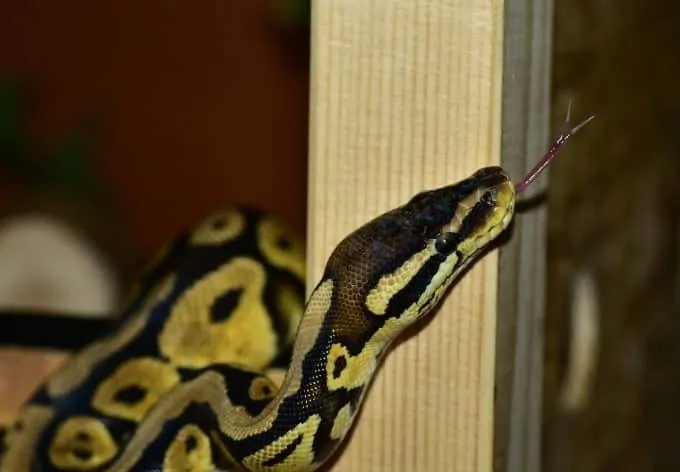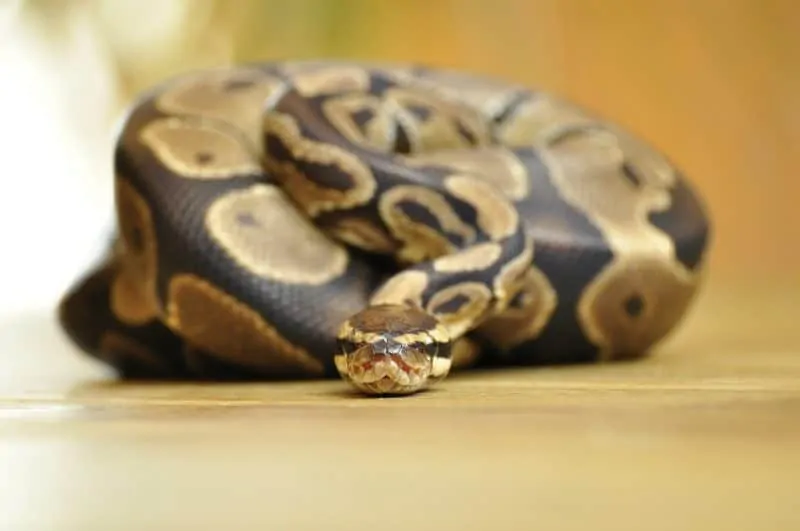A significant part of the appeal of ball pythons is the incredible colors and patterns some individuals exhibit. You may have to spend a pretty penny for some of the most mind-blowing animals, but even those with modest budgets can obtain a very attractive member of the species.
And if you are going to go to the trouble of buying a beautiful-looking ball python, you certainly want to show him off as best you can. To do that, you’ll need a high-quality lighting system.
Do Ball Pythons Need Light?
To the best of my knowledge, no one has ever performed experiments to determine if ball pythons can remain healthy in a pitch-black environment. Honestly, there’s no need to. While ball pythons may be physically capable of surviving without any light at all, this wouldn’t allow you to enjoy them. It may also reduce their quality of life.
The real question is do ball pythons need any type of special lighting? And the answer to that question is unequivocally “no.”
Your ball python does not require anything other than ambient room light to survive. Whether you keep your pet in an aquarium or a small plastic storage box, the light penetrating the enclosure walls will be more than enough for him to see and move around the habitat. After all, snakes rely primarily on their sense of smell, and ball pythons are largely nocturnal.
Do Ball Pythons Need UV Light?
Many popular lizard pets – especially heliothermic (sun-loving) species, such as bearded dragons and iguanas – require light that includes rays in the UVB portion of the spectrum to remain healthy. But the vast majority of snake species are thought to be capable of thriving without these high-frequency rays – and this includes ball pythons.
In fact, exposure to UVB light may cause health problems in some cases. Research has demonstrated that some lizards who require UVB light will move away from these lights or seek shelter from time to time.
Ultimately, it is not necessary to provide UVB light to ball pythons, and if you choose to do so for some reason, you should certainly be sure that your snake has shaded areas in the habitat into which he can retreat.
Do Ball Pythons Need a Heat Lamp?
Heat lamps are different from other types of enclosure lights. Heat lamps rely on incandescent bulbs, which produce a great deal of heat, but fairly low-quality light. By contrast, lights that are installed for aesthetic purposes are generally of the fluorescent or LED variety.
You don’t have to use heat lamps to provide warmth for your pet; you could use heat pads, heat tape or radiant heat panels instead. That said, heat lamps or “clamp lamps” are often the simplest way to heat a ball python enclosure, and they are likely the best option for beginning snake-keepers to use.
Fluker’s Repta-Clamp Lamp is one of the best options available, as it features a ceramic base and is rated for bulbs up to 150 Watts, yet it’s still quite affordable. It even has a built-in dimmer switch, which gives you some ability to adjust the habitat temperatures.
Zilla’s Premium Reflector Domes are a reasonable alternative, but they don’t come with the built-in dimmer switch that the Fluker model does.
You’ll also need a good incandescent bulb to use in these fixtures. In the old days, we’d just use a regular household lightbulb of the appropriate wattage. But as incandescent bulbs were largely phased out of the consumer market, this isn’t as easy to do. Instead, modern keepers should pick something like Exo Terra Daytime Heat Lamp is perfect.
Best Lamp & Lighting Setup
Even though ball pythons do not require special lighting, many keepers like to provide enclosure lighting to make the habitat and animal look their best. The easiest way to do so is by buying one or more of the fixtures discussed earlier, but instead of using a heat lamp bulb, use compact fluorescent bulbs instead.
Just remember that you want a light that produces a nice, balanced spectrum, but you don’t want a light that produces UVB in most cases. A good option is the Exo Terra Repti-Glo 2.0.
Do Ball Pythons Need a Day-Night Cycle?
No matter what type of lighting system you use for your ball python, it is important to provide your pet with a consistent day-night cycle. Failure to do so may lead to stress and it may even reduce your snake’s willingness to feed.
If you’re not intending to breed your ball python, a simple 12-hour cycle works perfectly. This would mean turning your snake’s lights on every morning at, say, 7:00 and then turning them off at 7:00 in the evening.
As you can imagine, it is often difficult to adhere to this kind of strict schedule over the long-term. Accordingly, many keepers opt to use a lamp timer to automate their snake’s day-night cycle. A simple timer – like this GE model – will certainly work, but a bit more money, you can pick up one with a ton of built-in features.
The Zilla Reptile Habitat Lighting Power Center is a great example, as it not only allows you to automate four devices simultaneously, it comes with a digital interface.
It’s your turn!
Your ball python may not need special lighting to remain healthy, but you’ll undoubtedly enjoy viewing him (and his enclosure) more if you implement a high-quality lighting system.
We appreciate you reading this article and hope you’ve found it helpful. Don’t forget to share it with your snake-keeping friends and share your comments and questions with us in the comments below.




18 Comments
I’ve had my ball python, Theo (male I think, 39in now) since 2018, which I believe is now fully mature. He is in a 55gal tank, with a 10gal tank (LED lighted, half filled, live plants with water filter) on the cool side as his water source. The heat sources are a 40-watt regular incandescent bulb for the day cycle, and a heat pad for night cycle.
Temp gauge shows 70F for day cycle. Humidity averages 70%. He spends the day cycle under his rock, and once in a while I catch him wandering around the tank in the night cycle.
Is this normal behavior? Is the temp too low? Does the regular incandescent bulb provide full spectrum light or I should change the bulb?
Hi,
It sounds like you are taking good care of Theo, your ball python. However, there are some things you may want to adjust in his enclosure to make him more comfortable and healthy.
I recommend the temperature on the warm side of the tank should be around 80-85°F (26-29°C), and the cool side should be around 75-80°F (24-27°C). A reading of 70°F (21°C) is a bit too cool for a ball python and may affect his digestion and metabolism.
Add a reptile-specific UVB bulb for 8-12 hours daily to promote Theo’s health and replace it every 12 months. Monitor humidity levels (50-60%) and adjust as needed with misting or water sources.
Hope this helps both you and Theo! 😊
Should the water be on the hot side of my terrarium or should it be over the rock my snake likes to climb on and be under?
Hi Samuel,
In general, the water dish in a snake’s terrarium should be placed on the cooler side of the enclosure. This is to prevent excessive evaporation, which can raise the humidity levels too high and potentially cause respiratory problems for your snake.
Also, placing the dish on the cooler side can give your snake a place to cool down if needed. Keep in mind, however, the dish should be big enough for your snake to fully submerge if it wishes to do so.
It’s not necessary to place the water over your snake’s favorite rock or hiding spot, but ensure there are suitable hides on both the warm and cool sides of the enclosure.
Remember to change the water regularly and keep the dish clean to avoid bacterial growth. Continue to educate yourself on the specific care requirements for your snake to ensure its well-being.
If the heat lamp is off at night, how would you provide heat? I have a glass tank, it does have heat tape, as well as is insulated on all sides of the tank but the front of it, I used reflectix..but that is not enough to provide adequate high temperatures at night. My light is currently on a timer where it shuts off when the appropriate temperature is reached, and turns back on when it drops. The heat tape is not on this timer.
Hi Letty,
If you need to provide heat at night when the heat lamp is off, you can use a ceramic heat emitter or an under-tank heating pad. These heat sources do not emit light and can be used to maintain the appropriate temperature in the enclosure at night. It’s important to use a thermostat to regulate the temperature and prevent overheating.
You mentioned that you have heat tape installed in your tank. You can also use this as a heat source at night by connecting it to a thermostat to regulate the temperature. This will allow you to maintain the appropriate temperature in the enclosure even when the heat lamp is off.
I just adopted my ball python. I have the heat lamp on from 7 am to around 7 pm in witch I turn on the black light. The snake loves the black light she comes out and just chills. I’m currently work on her aggression the pet store named her spicy. I’ve been getting her out 20 min two times a day and as far as I can see she’s starting to trust me. Am I doing this right?
Hey Candace,
It sounds like you are doing a great job with your ball python! The heat lamps and black light are very important to keep her environment ideal, and giving her time out of the enclosure will help socialize her. It’s common for pet store snakes to be scared or aggressive at first, so it’s good that she seems to be trusting you more over time.
Just keep up the same routine and be patient with her – she’ll come around and become more comfortable with you in no time!
Good luck! 🙂
I want to make sure I understand the lighting situation. I have the daytime blue light 100w and a heating pad on the side of the tank. Both on the same side. It is ok to turn the light off at night and just rely on the heat from the heating pad for the day/night cycle? Or is there something else that should be putting off heat when the light is off that does not light up??
Yes, it’s okay to turn off the daytime blue light at night and rely on the heat from the heating pad to maintain the appropriate temperature in the enclosure. It’s important to use a thermostat to regulate the temperature and prevent overheating.
Hello! I was wondering if anyone could tell me if “Fluker’s Daylight Neodymium, Incandescent, Full Spectrum Bulb 60 watt” is a good choice of heat for my Ball Python? Or are there much more suitable heat bulbs for Ball pythons?
Hello Llama ,
You’ve made a great choice with that bulb. It provides an appropriate level of heat for Ball Pythons and is very easy to install as well. The full spectrum feature also ensures that your snake benefits from the natural light needed for its health.
I would suggest pairing it with a thermometer just to make sure the enclosure temperature remains in the right range.
Best of luck!
Hey my daughter bought a ball python on the 17th of July, the store said he ate the week prior. He has not eaten since she got him.
She keeps it mostly dark in her room. He has a heat light.
So I’m thinking if I put a lamp in her room & turn it on in the mornings & off at bedtime, after a few weeks he’ll eat.
My daughter is getting concerned.
Thank you for your time.
Rhonda
Thanks for reaching out, Rhonda. If your ball python hasn’t eaten since your daughter got him, it’s definitely something to be concerned about.
There are a few things that could be causing this issue. It’s possible that the snake is still adjusting to its new environment and just needs some time to settle in. It’s also possible that the temperature in the room isn’t ideal for eating, or that the snake is feeling stressed for some other reason.
By slowly transitioning to a more regular light schedule, you may be able to encourage your python to start eating again. However, if your python does not start eating within a few weeks, it’s possible that there is another underlying health issue at play and you should consult with a reptile veterinarian. They can make sure that everything is okay and offer some advice on how to get the snake eating again.
Thanks,
Hi,
I just have a question about lighting. This article has great info but still a little confused. I have a male ball python who is about 2 years old. Ever since getting him a larger terrarium I can’t figure out the best way to heat it. It’s 4ft long 1 foot high 1ft deep (so long and skinny). I always used blue daytime bulbs in the past but when I got this they told me to use 2 red bulbs because it was a long enclosure. But 2 made it too hot so now I use one. And he has a heat pad underneath on his hot side. Lamp is also on the hot side. He rarely goes to the hot side and he has not been as active and is late on shedding. I just think the lighting is wrong. He has a hide on the hot side in the middle and on the cool side (3 total areas to hide). But he spends almost all his time in his hide in the middle of the terrarium. What would you recommend?
Hey Jennifer,
It sounds like you might be using too many heat sources in your terrarium. I would recommend only using one heat source, either a heat lamp or a heating pad. Make sure the temperature is adequate in your terrarium. The ideal temperature for the hot side is 90-95 ºF. You can find more information here.
Thanks
hello I have a ball python. I need some advice on how to keep his cage. It’s my daughters. I need something right now to help him stay comfortable and alive. The basic things for now. May you please help me out and let me know.
Hi Veronica,
Firstly you will need to get a suitable vivarium for your python, then place a suitable substrate for example orchid bark in the bottom. Provide a number of hiding places, a moist hide, branches to climb on and a water bowl. After this you will need to provide adequate heating and lighting for your python. Your python will require all of these to be set up properly plus weekly feeding in order for it to be healthy and happy. Please read through each of our guides on ball python habitat set up and care. Let me know if you have any further questions.